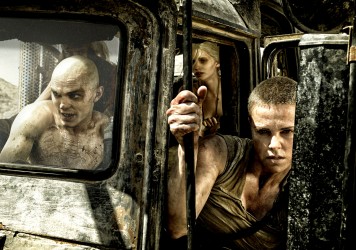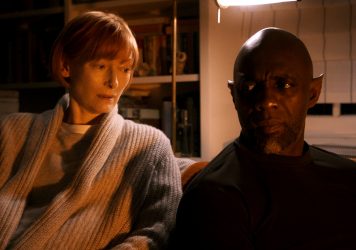George Miller fires up his war rig and roars across the Australian outback once more, this time telling the origin story of the fearsome Imperator Furiosa.
There are some cinema experiences that stay with you – one of mine is my first viewing of Mad Max: Fury Road, which occured at the Vue Leeds Kirkstall in the early hours of the morning on May 13 2015. I was a week away from handing in my university dissertation, and worked at the cinema as a customer assistant, slinging popcorn, cleaning up puddles of vomit and being berated by customers for important issues such as films not being very good or being unable to refund them for food they had already eaten. It was the best of times, it was the worst of times, but one of the redeeming features of working long hours for minimum wage was that the company would occasionally put on screenings for the staff, after hours when all the customers had gone home, of upcoming releases – partly as a treat, partly so we could tell customers what the film was about when they invariably asked us.
One of these screenings, at midnight on a balmy spring evening, was Mad Max: Fury Road. I remember this vividly because they decided to do a double bill of the film and Pitch Perfect 3, which played directly after on the same screen. And, of course, I remember it vividly because Mad Max: Fury Road was a fucking masterpiece, a bolt of pure cinematic lightning that electrified the small group of us who had bothered to stay after our shifts to watch it. I think of the film often, I quote the film often, I do a little Tom Hardy impression to amuse myself often. When a film lives so large not only in your memory but within the collective pop cultural atmosphere, the prospect of any sequel, prequel or spin-off is always met with considerable trepidation – not least when it comes a couple of years after a somewhat disappointing passion project.
A follow-up to Fury Road focusing on Imperator Furiosa, brought to life so magnificently by Charlize Theron in Fury Road, had originally been planned to shoot back-to-back with the first film, but this was nixed during pre-production, and the wheels on the war rig didn’t start to turn again until 2019, after a dispute about unpaid wages between WB and Miller was settled. Now, almost nine years to the day since Fury Road premiered at the Cannes Film Festival, Miller has returned, with Anya Taylor-Joy riding shotgun.
The story begins in the fabled Green Place, where Furiosa was raised by a female collective known as the Many Mothers or the Vuvalini, who had weathered the global collapse to create a lush commune, complete with solar and wind power, plentiful crops and a supply of fresh water. Crucially, the place is kept secret, lest it fall to the tribes of ravenous scoundrels who roam the wastes like locusts, keen to pick every scrap of meat from the bone. A young Furiosa (played in early scenes by Alyla Browne) is kidnapped by one such gang, who realise they can use her to impress their deranged leader Dementus (Chris Hemsworth), a self-styled legionnaire who commands a chariot powered by two motorbikes, and leads a hoard of leathered loons across the land. This doesn’t quite go to plan, as they are pursued by Furiosa’s equally ferocious mother (Charlee Fraser), but – as Fury Road viewers may remember – this rescue attempt has a rather tragic ending.
The young Furiosa finds herself taken prisoner, at the mercy of the cheery but insane Dementus, who has designs on ruling over three major settlements currently under the protection of Immortan Joe (Lachy Hulme as the wheezy warlord taking over from Hugh Keays-Byrne): Gas Town, the Bullet Farm, and The Citadel. While Dementus and Immortan Joe squabble over resources and power, Furiosa’s goals are more straightforward but no less difficult to achieve: she wants her freedom and she wants her vengeance, in this life or the next.

The uphill battle that this prequel faces to match the sheer kinetic force of Fury Road is in part down to that film’s simple structure – Fury Road was a road movie, which gives a sense of pace and urgency. In contrast, Furiosa takes place over several years, with characters popping in and out, and without a compelling supporting cast to rely on. Fury Road’s scowling, near-silent Max Rockatansky was well-balanced with Charlize Theron’s highly skilled, highly competent Furiosa, the wide-eyed but wily troupe of Immortan Joe’s escapee brides, and the manic wildcard war boy Nux. Furiosa is almost entirely alone, save for a brief alliance with Immortan Joe’s top war rig driver Praetorian Jack (Tom Burke, stoic with a grand antipodean accent, sadly underutilised). This places a lot of weight on Anya Taylor Joy’s shoulders, and while she saddles some of it easily – her recreation of Theron’s speech patterns is spot on – the sparse nature of her character seems to leave her struggling to operate on varying emotional levels.
But Taylor Joy is a committed action heroine, and the stunt set pieces are exhilarating and inventive, if not quite as awe-inspiring as those in Fury Road. Hemsworth is clearly having the time of his life, and although he seems perfectly content to keep making Marvel movies forever, this is a reminder he’s quite capable of doing more than that, believable as an apocalypse desert pirate with no fucks left to give and no idea what the hell he’s doing. Miller’s world-building is where the film truly comes alive. Although the Mad Max universe expands only slightly here, every addition – for example, The History Man, whose head-to-toe tattoos recall the entire history of the long-dead civilised world – feels thoughtful and genuinely interesting. This is a world that is fascinating to spend time in, even if it’s a barren rendering of hell on earth.
Miller is undoubtedly one of the best blockbuster filmmakers working today, possibly of all time, by nature of sheer imagination and scale alone. In an age where studios encourage filmmakers to make their action films quickly and cheaply (no matter how badly it might impact the VFX professionals or other crew members working on them), Furiosa proves that a better world is possible, one where a film exists with greasy, dirty fingerprints all over it – evidence that humans were behind every explosion, every sawn-off shotgun, every scuffed combat boot. The mammoth scale and vision of Miller continue to delight, and Furiosa absolutely deserves to be seen as big and loud as possible, a feat of technical prowess and cinematic ambition that only comes along once every few years (if we’re lucky!)
If Furiosa was a bolt from the blue, perhaps it might have had the same impact as Fury Road; its biggest hindrance is that it has to follow one of the greatest blockbusters of all time, and hews too closely to that template to truly find its own identity. While it’s absolutely a blast at the cinema, the dizzying heights that Miller drove us to back in 2015 aren’t quite matched second time around. But all is not lost: Furiosa is still miles better than the dreck Hollywood usually treats us to over the summer, and provided it doesn’t take another decade to get the Fury Road sequel that Miller has been promising, perhaps we’ll reach Valhalla yet.
Published 15 May 2024
Can any film hold a candle to the glorious carnage that was Fury Road?
Well, not quite, but Miller makes a bloody good go of it.
I live, I die, I live again!

The outer chassis may look battered and bruised, but there’s well-oiled action perfection under the bonnet.

Mad Max director George Miller returns to the big screen with an adaptation of modern-day fable The Djinn in the Nightingale's Eye.